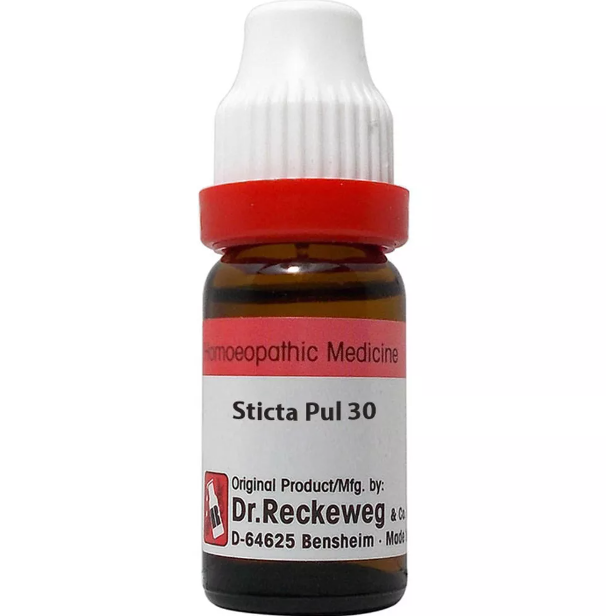STICTA PULMONARIA Q, 6C, 12C, 30C, 200C, 1M, 10M USES AND SYMPTOMS
 STICTA PULMONARIA
STICTA PULMONARIA
(Lungwort)
Stict.
Presents symptoms such as coryza, bronchial catarrh, and influenza, along with nervous and rheumatic issues. There’s a general sensation of dullness and fatigue, as with the onset of a cold; dull, heavy pressure in the forehead, catarrhal conjunctivitis, etc. Rheumatic neck stiffness (cervical spondylosis).
Mind: Feels as though floating in air (Dat-a., Lac-c.). Confusion of ideas; patient feels compelled to talk.
Head: Dull headache with heavy pressure in the forehead and root of nose. Catarrhal headache before discharge appears. Burning and soreness in the eyes. Sensation of scalp being too tight. Burning in eyelids.
Nose: Fullness at the root of the nose (Nux-v.). Atrophic rhinitis (Calc-f). Nasal membrane dry. Constant urge to blow the nose, yet no discharge. Dry scabs, especially in the evening and at night. Hay fever with incessant sneezing (Sabad.).
Abdomen: Diarrhea with profuse, frothy stools; worse in the morning.
Urinary: Increased urine, with soreness and aching in the bladder.
Female: Scant milk flow (agalactia).
Respiratory: Raw throat; mucus dropping posteriorly. Dry, hacking cough at night; worsened by inspiration (bronchitis). Tracheitis, aiding expectoration. Loose cough in the morning. Pain in the chest from sternum to spinal column (angina pectoris). Post-measles cough (Sang.); worse towards evening and with fatigue. Pulsations from the right sternum to the abdomen.
Extremities: Rheumatic pain in the right shoulder joint, deltoid, and biceps. Joint swelling, heat, and redness. Red, inflamed spot over the affected joint. Severe, drawing pain. Chorea-like spasms; legs feel like floating in air. Housemaid’s knee (Rhus-t., Kali-i., Slag). Shooting knee pain. Red, swollen, painful joints and adjacent muscles. Rheumatic pain preceding catarrhal symptoms.
Modalities: Worse with sudden temperature changes.
Relationship: Compare: Dat-a., Bougmanica (inability to concentrate; brain feels overwhelmed. Sensation of floating ideas. Headache, heartburn. Burning near cardiac end of the stomach, radiating to the esophagus, with a sense of constriction. Heat and fullness over the liver). Cetraria-Iceland moss (chronic diarrhea, phthisis, hemoptysis. Used as a decoction with milk for bronchorrhea, catarrh, etc.). Also compare: Eryngium, Dros., Still., Rumx., Samb.
SYMPTOMS OF STICTA PULMONARIA
Mind:
Sensation of floating in air.
Confusion of ideas and a need to talk.
Head:
Dull headache with pressure in the forehead and root of the nose.
Catarrhal headache (before nasal discharge).
Burning sensation in the eyes, soreness, and tight feeling in the scalp.
Nose:
Fullness sensation at the root of the nose.
Atrophic rhinitis with dryness of nasal membranes.
Frequent need to blow the nose but no discharge; dry nasal scabs.
Hay fever with constant sneezing.
Abdomen:
Profuse, frothy diarrhea, worse in the morning.
Urinary:
Increased urination with soreness and aching in the bladder.
Female:
Scanty milk flow (agalactia).
Respiratory:
Raw throat with mucus dropping down.
Dry, hacking cough, especially at night, worsened by deep breaths.
Loose cough in the morning.
Chest pain radiating from the sternum to the back (angina pectoris).
Cough after measles, worse in the evening and with fatigue.
Extremities:
Rheumatic pain in the right shoulder joint, deltoid, and biceps.
Joint swelling, redness, and inflammation.
Severe drawing pain in joints.
Chorea-like leg spasms and shooting pain in knees.
Rheumatic pains before the onset of catarrhal symptoms.
Modalities:
Symptoms worsen with sudden temperature changes.
selection of the potency
Individualization:
- Homeopathy is based on the principle of treating the individual, not just the disease. The unique symptoms and characteristics of the person are crucial in determining the most suitable potency.
Intensity of Symptoms:
- The intensity of the symptoms guides the choice of potency. If the symptoms are intense and acute, a lower potency (e.g., 6C, 30C) might be considered. For chronic conditions with less intensity, higher potencies (e.g., 200C, 1M) may be appropriate.
Sensitivity of the Patient:
- Some individuals are more sensitive to homeopathic remedies, while others may require higher potencies. The practitioner considers the patient’s sensitivity when selecting the potency.
Acute vs. Chronic Conditions:
- Lower potencies are often used for acute conditions, while higher potencies may be considered for chronic or long-standing issues.
Previous Response to Potencies:
- The patient’s response to previous homeopathic treatments helps guide the choice of potency. If a particular potency has been effective in the past, it may be repeated or adjusted as needed.
Vital Force and Susceptibility:
- Homeopathy views illness as a disturbance in the vital force. The practitioner assesses the patient’s overall vitality and susceptibility to determine the appropriate potency.
Aggravation or Amelioration:
- The direction of the symptom response (aggravation or amelioration) after taking a remedy can influence the choice of potency.
Miasmatic Considerations:
- In classical homeopathy, the concept of miasms (inherited disease tendencies) is considered. The practitioner take this into account when selecting the potency.
Practitioner Experience:
- The experience and preference of the homeopathic practitioner play a role. Some practitioners may have success with certain potencies based on their clinical experience.
SAFETY INFORMATION
- Do not exceed the recommended dose by physician
- Keep out of the reach of children
- Store in a cool dry place away from direct sunlight
- Maintain half an hour gap between food/drink/any other medicines and homoeopathic medicine
- Avoid any strong smell in the mouth while taking medicine e.g. camphor, garlic, onion, coffee, hing
Medicine images use for reference only selection of homeopathic medicine depends on the individual’s specific symptoms and overall constitution. Moreover, homeopathy is a holistic system of medicine that treats the individual as a whole. In addition to addressing the physical symptoms, it takes into account the emotional and mental state of the person. Consequently, it’s crucial to consult with a qualified homeopathic practitioner for personalized treatment.
The information provided on this website is intended solely for educational purposes. Always seek the advice of your physician or other qualified health provider.
